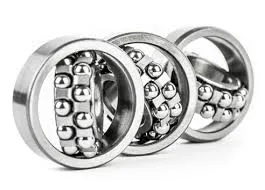
Dec . 19, 2024 04:51 Back to list
Understanding the Performance and Applications of Metric Tapered Roller Bearings
Understanding Metric Tapered Roller Bearings
Metric tapered roller bearings are crucial components in various machines and equipment, renowned for their ability to support both radial and axial loads. Unlike conventional cylindrical roller bearings, which can only handle radial forces, tapered roller bearings are uniquely designed with conical rollers that allow them to accommodate axial loads in one direction. This article delves into the structure, applications, and benefits of metric tapered roller bearings, highlighting their importance in engineering and manufacturing.
Structure of Tapered Roller Bearings
At first glance, tapered roller bearings appear as a set of conical rollers situated between two rings—the inner ring (also known as the cone) and the outer ring (the cup). The tapered shape of the roller is designed so that the lines along their contact points converge at a common axis. This angle allows the bearing to efficiently manage the forces applied to it, making it particularly effective in scenarios where both radial and axial loads are present.
Metric tapered roller bearings are distinguished by their size specification system, provided in millimeters, making them compatible with various international machinery standards. This metric nomenclature helps engineers and manufacturers select the right bearing for their specific applications easily.
Applications of Metric Tapered Roller Bearings
The versatility of metric tapered roller bearings makes them ideal for a wide range of industrial applications. These bearings are commonly used in
1. Automotive Industry They play a vital role in vehicle wheel hubs, helping to support both the rotating wheels and the axial forces generated during driving.
3. Aerospace Tapered roller bearings can be found in various aircraft components, including landing gears and engines, where reliability under stress is paramount.
metric tapered roller bearings

4. Manufacturing Equipment In a manufacturing setting, these bearings facilitate smoother operations of conveyor systems, mills, and tachometers, improving efficiency and reducing downtime.
5. Electric Motors Tapered roller bearings are also present in various electric motor designs, where they support both radial and axial loads and help ensure longevity and performance.
Advantages of Tapered Roller Bearings
One of the primary benefits of using metric tapered roller bearings is their load distribution capabilities. The conical shape of the rollers enables a larger contact area with the raceways, resulting in improved load handling. This characteristic significantly enhances the bearing’s lifespan, making it a cost-effective solution in the long run.
Furthermore, the ability to handle both radial and axial loads means fewer bearings are required for specific applications, simplifying designs and possibly reducing costs. Maintenance is generally straightforward, as these bearings can often be lubricated using standard procedures, ensuring they function optimally over time.
Choosing the Right Metric Tapered Roller Bearing
Selecting the right metric tapered roller bearing involves understanding several key factors
- Load Requirements Consider the maximum radial and axial loads the bearing will encounter. - Speed Determine the operational speed since bearings have varying speed ratings. - Environmental Conditions Consider factors such as temperature, humidity, and exposure to contaminants, which can influence bearing performance. - Assembly and Installation Proper fitting is crucial to ensure functionality; both the inner and outer rings should be installed with the correct tightness to avoid excess play or misalignment.
Conclusion
In summary, metric tapered roller bearings are indispensable components within a plethora of industrial applications, delivering exceptional support for both radial and axial forces. Their unique design promotes improved load distribution, longevity, and simpler maintenance than traditional bearings. With the right selection based on application requirements, these bearings can significantly enhance the reliability and efficiency of machinery, contributing to smoother operations across various sectors. As industries continue to evolve, the demand for high-performance components such as metric tapered roller bearings will undoubtedly rise, affirming their critical role in modern engineering and manufacturing.
Latest news
-
Premium Deep Groove Ball Bearings | High Speed & Reliability
NewsAug.29,2025
-
Durable Scaffolding Clamps - Secure & Reliable Tube Connectors
NewsAug.28,2025
-
Common Failures in Thrust Ball Bearings and Solutions
NewsAug.22,2025
-
How Tapered Roller Bearings Can Take Shock Loads
NewsAug.22,2025
-
Angular Bearings in High-Precision Spindles
NewsAug.22,2025
-
The Impact of Misalignment on Cylindrical Roller Bearing Performance
NewsAug.22,2025
